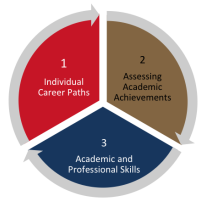Online Tutorial on Gender Bias in Appointment Procedures
 From a legal standpoint, women and men have the same chances and opportunities when it comes to work. In practice, however, the situation is oftentimes quite different. Academic careers, for instance, are affected negatively by gender bias. But which factors specifically influence and inform the assessment of applicants? This online tutorial sheds light on this question in three modules, which cover important topics relating to appointment procedures: individual career paths, the assessment of academic achievement, and academic as well as professional skills.
From a legal standpoint, women and men have the same chances and opportunities when it comes to work. In practice, however, the situation is oftentimes quite different. Academic careers, for instance, are affected negatively by gender bias. But which factors specifically influence and inform the assessment of applicants? This online tutorial sheds light on this question in three modules, which cover important topics relating to appointment procedures: individual career paths, the assessment of academic achievement, and academic as well as professional skills.
Let’s get started: Get informed – whenever, wherever and in whichever form you want
All three modules are structured in the same way: First, a short introduction to the topic is provided, followed by a description of the underlying problem, highlighting individual features and discussing the effects of gender bias in context. In a final step we offer four recommendations on how to avoid gender bias.
You can work through each module separately or in succession. Our online version offers an audio commentary that guides you through each module. PDF versions of the modules are available for download, too.
Module 1: Individual Career Paths
 Listen to and view module 1 "Individual Career Paths" (duration: 16 minutes)
Listen to and view module 1 "Individual Career Paths" (duration: 16 minutes)
 PDF version of module 1 "Individual Career Paths"
PDF version of module 1 "Individual Career Paths"
Module 2: Assessing Academic Achievements
 Listen to and view module 2 "Assessing Academic Achievements" (duration: 15 minutes)
Listen to and view module 2 "Assessing Academic Achievements" (duration: 15 minutes)
 PDF version of module 2 “Assessing Academic Achievements”
PDF version of module 2 “Assessing Academic Achievements”
Module 3: Academic and Professional Skills
 Listen to and view module 3 "Academic and Professional Skills" (duration: 11 minutes)
Listen to and view module 3 "Academic and Professional Skills" (duration: 11 minutes)
 PDF version of module 3 “Academic and Professional Skills”
PDF version of module 3 “Academic and Professional Skills”
Background Information: Online Tutorial
Beyond the legal provisions regarding equal opportunity, careers of women and men are affected by gender stereotypes that are activated instinctively or deliberately. Especially the barriers that exist in our minds, those of our colleagues or HR personnel, lead to unequal treatment of women and men in appointment procedures. Here, a major issue is the assumption of traditional gender roles, which leads to stereotypical notions about, for instance, different career paths of women and men in academia. With such instinctive assumptions being in effect, the range of factors influencing and shaping an academic career are simply overlooked. This online tutorial developed by the Equal Opportunities Office of Heidelberg University identifies three areas in which gender bias oftentimes plays an important role. While providing information on each of these topics, the tutorial also offers recommendations on how to deal with and avoid gender bias in appointment procedures. The information given is based on current research findings in the field of psychology and business, as well as on relevant legal bases.
Link to Test own Stereotypes
To test how strongly we are influenced by stereotypes and prejudice, you can complete an Implicit Association Test (IAT) devised by “Project Implicit”, which lets you explore attitudes about gender, amongst other topics: https://implicit.harvard.edu/implicit/.
Recommended Reading
If you do not have the time right now to complete our online tutorial, we recommend reading the article “Scientists of the World Speak up for Equality“ in Nature (March 2013, volume 495), which is available online: http://www.nature.com/nature/journal/v495/n7439/full/495035a.html
Poster campaign
Here you can find the complementary poster campaign.

